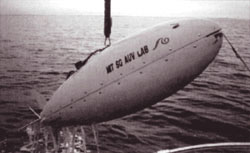Riding the waves
 oceanographers in the us have successfully tested a new approach called real- time oceanography or adaptive sampling, which gives them a better picture of water movements and enables them to modify their plans midway through an experiment to follow a clue suggested by new data. The new technology could be immensely useful in tasks such as monitoring oil spills, tracking pollution and searching for objects on the sea-bed ( Science , Vol 275, No 5308).
oceanographers in the us have successfully tested a new approach called real- time oceanography or adaptive sampling, which gives them a better picture of water movements and enables them to modify their plans midway through an experiment to follow a clue suggested by new data. The new technology could be immensely useful in tasks such as monitoring oil spills, tracking pollution and searching for objects on the sea-bed ( Science , Vol 275, No 5308).
Usually, oceanographic experiments consist of vast data-collection expeditions with limited flexibility. Ship schedules are too rigid and data analysis too slow for oceanographers to modify their plans in the course of their experiments. "Normally, we take our measurements and are long gone by the time we are able to analyse the data,' says Henrik Schmidt, an ocean engineer at the Massachusetts Institute of Technology ( mit) .
Last summer, scientists from the mit and Harvard University, armed with robotic submersibles, sensors, acoustic transmitters and receivers, tried the new approach in the Haro Strait, a narrow channel clogged with freighters between Vancouver Island and Washington state. They were trying to trace a tidal front in the strait
Related Content
- Human rights outlook 2023
- Riding the wave: an East Asian miracle for the 21st century
- Three stocks to ride the green energy wave
- Pope sets up yearly Catholic Church day of care for environment
- Mamata rejects 27-lakh cheque from Tata electoral trust
- Green group uses Nano to hit Tatas on Orissa turtles
